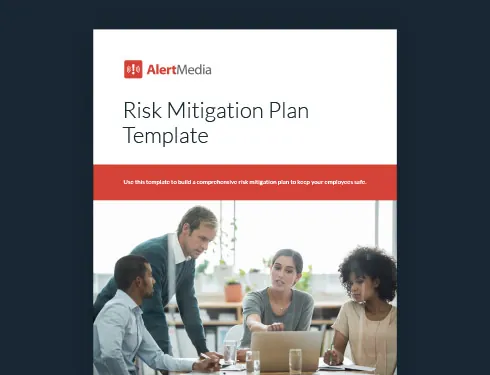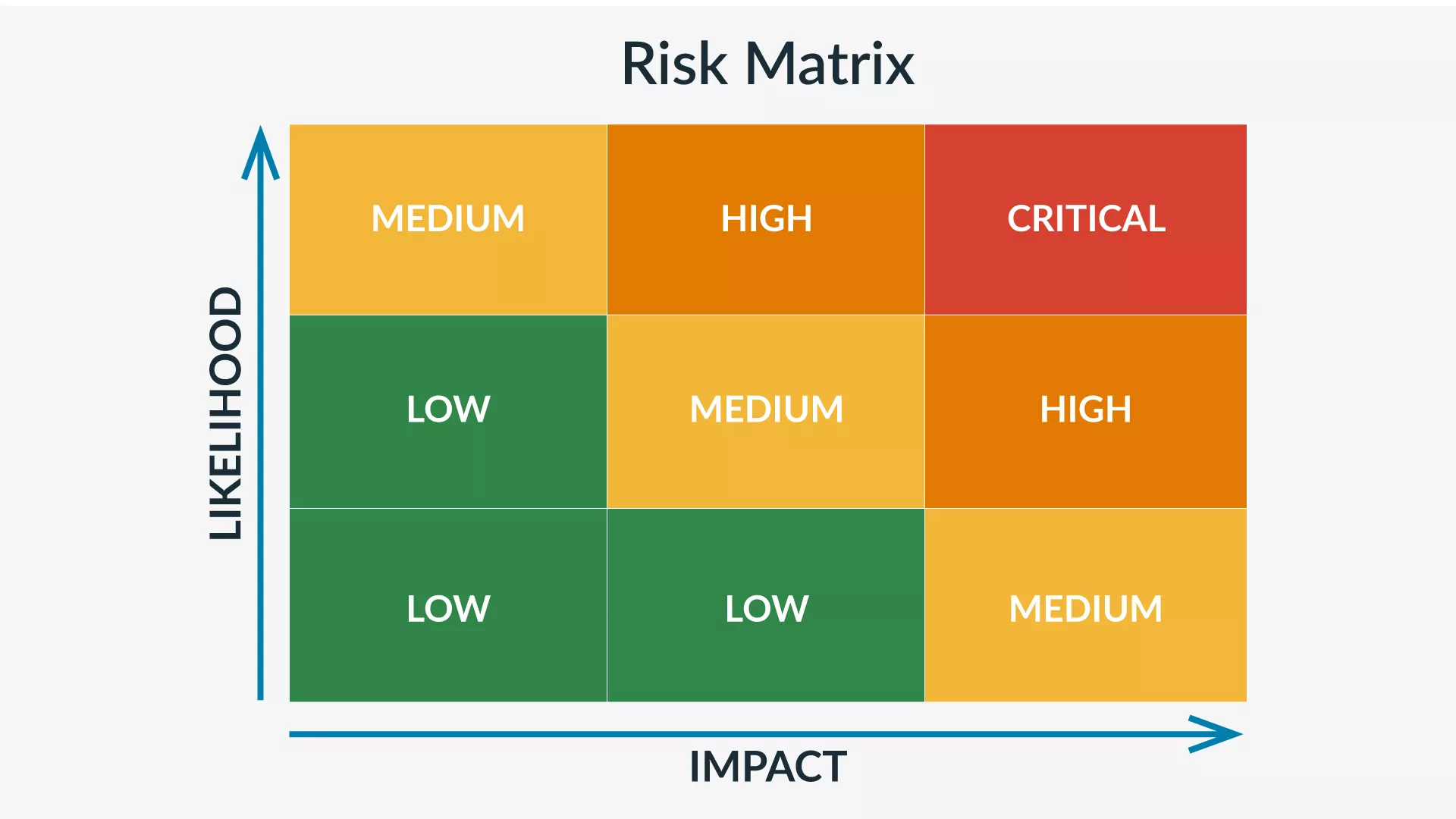
Your business shouldn’t falter when faced with a problem. Learn to adapt and react to any disruption quickly and confidently with a risk management plan.
Risk Mitigation Plan TemplateUse this template to build a comprehensive plan that helps reduce the negative effects of threats and disasters on your business.

Knowing what could go wrong is the first step to making things go right—from protecting employee safety to ensuring smooth project success to managing complicated supply chains.
Thinking proactively about your potential risks is key, explains Lukas Quanstrom, Co-Founder and CEO of Ontic, in an interview on The Employee Safety Podcast. “By adopting a proactive security approach, you can collect pre-incident threat indicators to gather critical knowledge needed to prevent bad things from happening. These pre-incident indicators come in many forms: perhaps it’s a threatening letter, a dark-web post, or an employee tip.”
This approach is known as risk management, a system that applies to all industries and professionals responsible for project management, business continuity, and security. For any team, a risk management plan is a necessary blueprint that outlines how to prioritize and handle risks so you can minimize their impact on the organization’s objectives and projects.
The more prepared you are before an event occurs, the faster you can respond and the less likely it is to bring your business to a screeching halt.
A risk management plan (RMP) documents all the potential risks and obstacles that could impact a given project or initiative. The document’s purpose is to list a range of things that could go wrong and to explain how the team will track, manage, and/or eliminate those risks that get in the way of project objectives.
Other documents like business continuity plans, disaster recovery plans, and risk assessments are similar but generally cover a much larger scope and account for a broader set of potential threats.
The kinds of risks you cover in a risk management plan will be more focused, with targeted reporting and response requirements. For example, one risk to a project could be a key team member taking unexpected time off due to illness or injury. The risk management plan should outline the potential impact, how to deal with the scenario, and who will be involved in addressing any skill or labor gaps.
Project risk management plans are a great tool for project managers and emergency managers alike. These plans are:
Risk management plans are ubiquitous and applied in every industry. Safety leaders from across the country have shared their own unique risk management plan templates and methodologies. Download this free template to make building your own plan much easier.
You can also explore the following examples to help get you started:
Building a risk management plan can seem incredibly intimidating, but it doesn’t have to be.
Here is what the process looks like:
The first step is determining who should be involved in your risk management plan. This should include any project managers or team leaders, key employees involved, and additional stakeholders.
Decide who needs to be involved, and then create a communication plan for when and how you will bring them into the planning process. Some stakeholders will need to be involved in creating the plan while others will only need to be informed once it is complete.
When you have a list put together, set up a meeting with everyone involved in the plan’s creation so you can collect all the information at one time.
This video will help you facilitate an effective risk assessment at your organization.

Next, perform risk identification to determine what risk events you face and qualify them to help you better prepare. The level of detail you go into in this step will greatly depend on your organization’s scale, industries, deliverables, and a project’s importance to the business. The bigger and more critical the project is, the more detailed your risk analysis should be.
“NOTE: If you can’t gather all key stakeholders together to identify the possible risks, make sure to request feedback from each of them on the list. Anticipating all the different factors on your own will be difficult, and you might miss an important risk that a stakeholder would readily recognize.”
The best way to do this is to gather all the key stakeholders together and make a list of all potential impacts. These can be as simple as running out of a key resource or as complicated as an unexpected natural disaster, but they should all clearly pose a risk to the completion or deadline of the project.
Suppose you are integrating a risk management plan into your existing emergency plan. In that case, you can use your risk assessments or business continuity plans as references for figuring out what risks your business usually faces.
Once you have your list of known risks, qualify the level of risk in each case. The best way to do this is to create a risk assessment matrix.

A risk matrix maps each risk on two dimensions: the likelihood and the expected impact. If a risk has a low probability and low impact, it will be much easier to manage and can likely be dealt with once it occurs. However, mitigating negative impacts should be a higher priority if a risk has a high probability and a severe impact.
Once you have identified and assessed all your potential risks, you can track them in a risk register. A risk register is a risk assessment tool that serves as a centralized database for identifying, assessing, and managing risks associated with a business operation or project. It expands on your risk assessment to include information like the description of each risk, the probability of occurrence, the potential impact of the risk, any mitigation actions, and risk response statuses.
What is most important about identifying risks is that you know what to expect, can plan out your risk response plan, and can develop an appropriate course of action in conjunction with other stakeholders. While there will always be uncertain events you cannot predict in advance, the more you can identify and monitor risks up front, the more likely you will react quickly instead of feeling overwhelmed or confused about how to respond.

Once you have your list of identified risks mapped out in a risk matrix, the next step is to plan your risk response for each scenario.
Here are several different types of responses you can employ:
Make a change in the project to neutralize this risk (eliminating potential points of failure, addressing identifiable gaps, etc.).
Shift responsibility of the risk to another party, like a contractor or a different team that is better equipped to handle the situation.
MitigationAttempt to manage risks by taking early action and performing risk monitoring. These risk management activities ensure the project progresses without hiccups.
Accept the risk and the consequences without intervening, and budget (time and money) accordingly into the project plan.

Get expert insights on the critical events that shaped 2024 to better protect and prepare your business in the year ahead.
Your response will depend on where the risk falls on the matrix. High-level risks should typically be discussed with project stakeholders and avoided whenever possible, while low-level risks might be accepted or mitigated. Identifying the best response to each threat before the project starts will give you ample time to act.
Again, you can pull successful responses from your other emergency planning documents, but make sure to specify how your response will be tailored to the scope of this project. In case your original action plan fails, you’ll also want to include contingency plans for high-impact threat responses.
Another critical factor in planning your risk response is assigning a specific person to each action or response step. This “risk owner” should be accountable for portions of your overall risk management strategy and training on any risk management processes relevant to their job function. Out of the key stakeholders (and anyone else involved in the project), pick one party responsible for each action and clearly explain what they might need to do.
Now that you have your list of risks and your responses planned out, it’s time to document.
Clearly lay out each risk and your response strategy. Make sure you include who is responsible for enacting the response plan. You’ll also want to document how you will gauge the success of your risk mitigation strategies and how you will communicate progress. Ensure that whoever is responsible for tracking the outlined risks knows who to contact for each possible response.
With your risk management plan put together, distribute it to each person involved in the project, even if they are not responsible for any of the risk responses. That way, everyone on the project knows who to go to if a risk does arise.
Like any planning document, your risk management plan should not be static. Effective risk management requires constant adaptation. As the organization evolves, or throughout the project lifecycle, internal and external conditions may change in a way that leads to new risks. Conducting periodic reviews of your plan will help you check that the documented risk management strategies remain aligned with the current risk landscape.
This process also provides an opportunity to evaluate the effectiveness of any risk responses that have been implemented so you can improve them. It provides an opportunity to re-engage risk management team members, report on key metrics and milestones, and adjust training and communication.
Risks are inherent in every business decision, but having a dynamic and well-communicated risk management plan can prepare you to make informed decisions and mitigate harm. When you integrate these plans with a reliable emergency communication system, you ensure you can rapidly contact anyone on your team, anywhere in the world, at a moment’s notice.